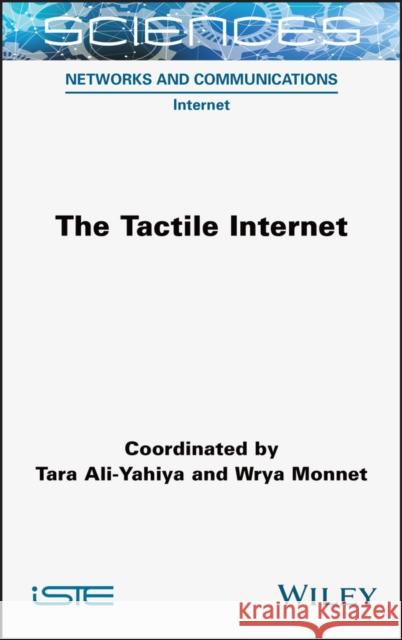The Tactile Internet » książka



(netto: 639,54 VAT: 5%)
Najniższa cena z 30 dni: 666,00 zł
ok. 30 dni roboczych
Bez gwarancji dostawy przed świętami
Darmowa dostawa!
Foreword xiIan F. AKYILDIZPreface xiiiTara ALI-YAHIYA and Wrya MONNETList of Acronyms xvChapter 1. Introduction to Tactile Internet 1Tara ALI-YAHIYA1.1. Human perception and Tactile Internet 21.2. The roadmap towards Tactile Internet 31.3. What is Tactile Internet? 51.4.Cyber-Physical Systems and TI 71.4.1.Physical world 71.4.2. Internet of Things 71.4.3.Communication 71.4.4.Storage and computation 81.4.5.Feedback 81.4.6.Smart computing 101.5.References 11Chapter 2. Reference Architecture of the Tactile Internet 13Tara ALI-YAHIYA2.1. Tactile Internet system architecture 132.2. IEEE 1918.1 use cases 152.2.1.Teleoperation 162.2.2.Automotive 172.2.3. Immersive virtual reality (IVR) 172.2.4. Internet of drones 182.2.5. Interpersonal communication 182.2.6.Live haptic-enabled broadcast 192.2.7. Cooperative automated driving 192.3.Conclusion 202.4.References 20Chapter 3. Tactile Internet Key Enablers 21Tara ALI-YAHIYA3.1. Introduction 213.1.1. The fifth-generation system architecture 213.1.2.Network slicing 233.1.3.Network function virtualization 253.1.4.Software-definednetworking 263.1.5.Edge computing 273.1.6. Artificial intelligence 293.2.Conclusion 313.3.References 31Chapter 4. 6G for Tactile Internet 35Pinar KIRCI and Tara ALI-YAHIYA4.1. Introduction 354.2.The architecture of 6G 374.2.1.Network performance of 6G 384.2.2.Space network 394.2.3.Air network 404.2.4. Ground network 404.2.5.Underwater network 414.3. 6G channel measurements and characteristics 414.3.1.Optical wireless channel 414.3.2. Unmanned aerial vehicle (UAV) channel 424.3.3.Underwater acoustic channel 434.3.4. Satellite channel 434.3.5.RF and terahertz networks in 6G 454.3.6. Visible light communication technology 484.3.7. Orbital angular momentum technology 484.4.6Gcellular Internet of Things 494.5. Energy self-sustainability (ESS) in 6G 504.6. IoT-integrated ultra smart city life 524.7.AI-enabled6Gnetworks 554.8. AI- and ML-based security management in super IoT 594.9.Security for6G 604.10. The WEAFMnecosystem(water, earth, air, fire micro/nano ecosystem) with 6G and Tactile Internet 614.11.References 63Chapter 5. IoT, IoE and Tactile Internet 65Wrya MONNET5.1.From M2M to IoT 665.2. Classification of remote monitoring and control systems 665.3. IoT-enabling technologies 675.3.1. IoT hardware 675.3.2. IoT software 675.3.3. IoT connectivity 675.4. Architectural design and interfaces 685.5. IoT communication protocols 715.5.1. Message Queuing Telemetry Transport (MQTT) 725.5.2. Constrained Application Protocol (CoAP) 745.5.3. Data Distribution Service for real-time systems (DDS) 765.5.4. Open Mobile Alliance Device Management (OMA-DM) 795.6. Internet of Everything(IoE) 805.6.1. Enabling technologies for the IoE 815.7. Protocol comparisons and the readiness for TI 825.8. TI-IoT models and challenges 835.9.Edge computing in the IoT 855.9.1.Edge computing paradigms 865.10. Real-time IoT and analytics versus real time in TI 885.11.From IoT towards TI 885.12.Conclusion 905.13.References 91Chapter 6. Telerobotics 95Wrya MONNET6.1. Introduction 956.2.Teleoperation evolution to telepresence 966.3.Telepresence applications 976.4. Teleoperation system components 996.4.1.Master domains 1026.4.2. Network domain (communication channel) 1026.4.3.Slave domain 1026.5. Architecture of bilateral teleoperation control system 1036.5.1. Classification of the control systems architectures 1066.5.2. Discrete architecture with transmission delay 1076.6. Performance and transparency of telepresence systems 1106.6.1. Passivity and stability 1106.6.2.Time delay issues 1126.7. Other methods for time-delay mitigation 1166.8.Teleoperation over the Internet 1176.9. Multiple access to a teleoperation system 1196.10.A use case 1216.11.Conclusion 1226.12.References 122Chapter 7. Haptic Data: Compression and Transmission Protocols 127Wrya MONNET7.1. Introduction 1277.2.Haptic perception 1287.2.1.Human haptic perception 1287.2.2. Telerobotic tactile and haptic perception 1287.2.3. Tactile sensing for material recognition 1297.2.4. Tactile sensing for object shape recognition 1307.2.5. Tactile sensing for pose estimation 1317.3. Haptic interfaces 1337.3.1.Haptic interface for telepresence 1337.3.2. Haptic and tactile sensors and actuators 1357.4.Haptic compression 1397.5.Haptic transport protocols 1427.5.1.Application layer protocols 1437.5.2.Transport layer protocols 1467.6. Multi-transport protocols 1497.7.Haptic transport protocol performance metrics 1497.8.Conclusion 1507.9.References 150Chapter 8. Mapping Wireless Networked Robotics into Tactile Internet 155Nicola Roberto ZEMA and Tara ALI-YAHIYA8.1.Wireless networked robots 1558.2.WNR traffic requisites 1588.2.1.Types of traffic in WNRs 1588.3.Traffic shaping and TI haptic codecs 1608.3.1. Introduction 1618.3.2.Mapping WNR control traffic toTI 1618.4. WNRs in the Tactile Internet architecture 1648.4.1.WNRs in the TI architecture and interfaces 1658.5.Conclusion 1698.6.References 170Chapter 9. HoIP over 5G for Tactile Internet Teleoperation Application 173Tara ALI-YAHIYA, WryaMONNET and Bakhtiar M. AMIN9.1.Relatedworks 1749.2. 5G architecture design for Tactile Internet 1799.2.1. Tactile edge A 1809.2.2.Network domain 1829.2.3. Protocol stack of 5G integration with IEEE 1918.1 1829.3.Haptics over IP 1839.4.Teleoperation case study 1859.4.1. Master to slave (uplink) data rate in edge A 1879.4.2. Slave to master (downlink) data rate in edge B 1879.4.3.Encapsulating the haptic data in HoIP 1889.4.4. 5G network data and control handling 1889.4.5.Case study operational states 1909.4.6.Case study protocol stack 1919.5.Simulation results 1929.5.1. Simulation topology 1939.5.2.NS3 network architecture 1949.5.3.Simulation scenario 1969.5.4.Simulation results 1989.6.Conclusion 2039.7.References 203Chapter 10. Issues and Challenges Facing Low Latency in the Tactile Internet 209Tara ALI-YAHIYA10.1. Introduction 20910.1.1. Technical requirements for the TI 21110.2. Low latency in the Tactile Internet 21210.2.1.Resource allocation 21210.2.2.Mobile edge computing 21310.2.3.Network coding 21410.2.4.Haptic communication protocols 21410.3. Intelligence and the Tactile Internet 21610.4. Edge intelligent 21610.5.Open issues 21910.6.Conclusion 22010.7.References 221List of Authors 227Index 229
Tara Ali-Yahiya is Associate Professor at Paris-Saclay University, France. She is deputy head of the Networking & Stochastic and Combinatorial Optimization Team at LISN Laboratory. She has an HDR, PhD and MSc in Telecommunications and was a post-doctoral researcher at Telecom SudParis.Wrya Monnet is a faculty member of the CSE department at the University of Kurdistan Hewler, Iraq. He has 23 years of experience in industry and academia and has done post-doctoral research at Telecom SudParis, France. He worked as an R&D and embedded software engineer for 10 years.
1997-2025 DolnySlask.com Agencja Internetowa
KrainaKsiazek.PL - Księgarnia Internetowa









